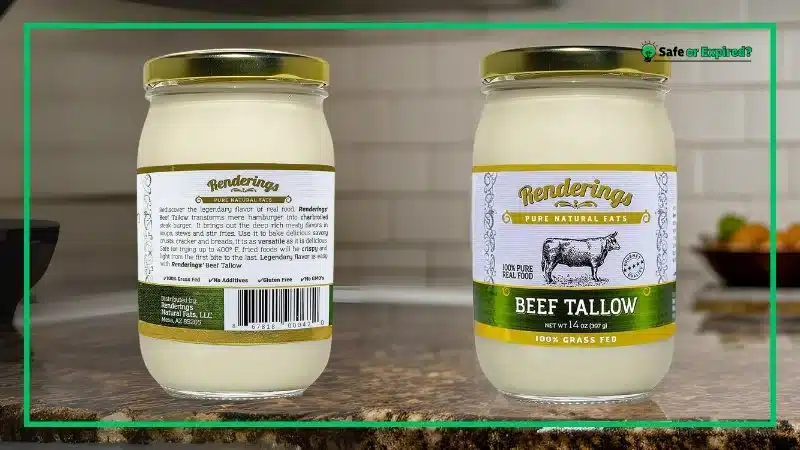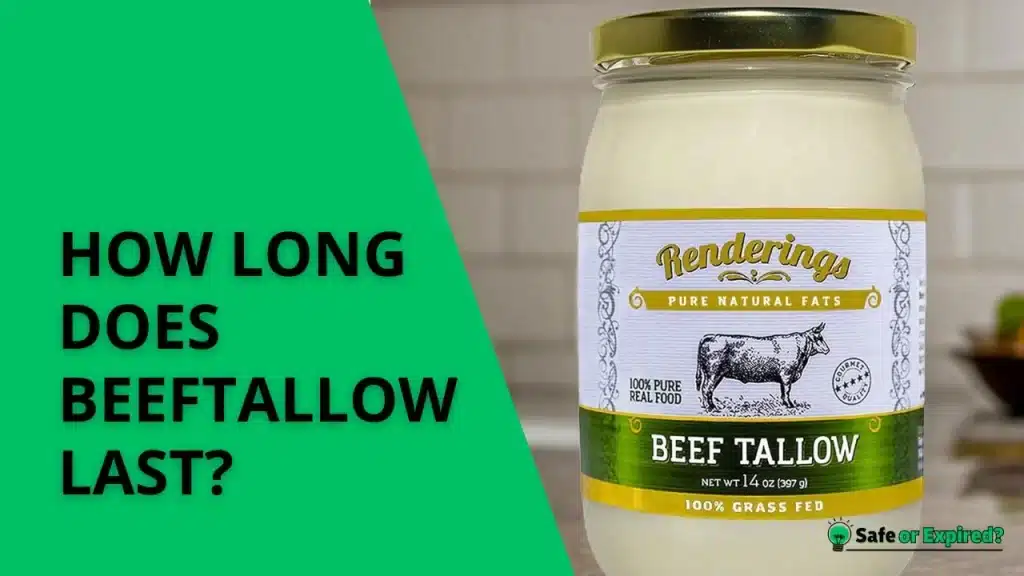“How long does beef tallow last?” is a common concern for chefs. Whether stored in the pantry, fridge, or freezer, beef tallow can remain usable from a few weeks to several years based on how you store it.
This guide will walk you through the best practices to ensure your tallow stays fresh and flavorful. Keep reading to uncover some surprising tips to extend tallow’s shelf life!
How Long Does Beef Tallow Last? All you need to know
Beef tallow, when stored properly, can last for an extended period due to its stable saturated fat content. Generally, beef tallow can be kept for several months up to a year if it is stored in a cool, dark place and in an appropriate container to prevent oxidation and rancidity.
How Long Does Beef Tallow Last in the Fridge?
When refrigerated, beef tallow can last even longer. Typically, it remains good for 6 to 12 months in the refrigerator. Keeping it chilled slows down any potential spoilage and helps maintain its quality and freshness.
Does Beef Tallow Need to Be Refrigerated After Opening?
Refrigeration is recommended for beef tallow after opening to maintain its quality. While it doesn’t spoil immediately at room temperature, keeping it in the fridge prevents it from becoming rancid over time, especially if you plan to keep it for several months.
How Long Does Beef Tallow Last at Room Temperature?
Beef tallow can last at room temperature for a considerable time if kept away from direct sunlight and in a cool, dark place. Generally, it can stay good for up to a month, but for optimal freshness and to avoid rancidity, storing it in cooler conditions is advisable.

How Long Does Beef Tallow Last in the Freezer?
For long-term storage, freezing beef tallow is highly effective. In the freezer, it can last up to a year or more without significant changes in quality. Freezing tallow helps preserve its natural flavors and nutritional properties over an extended period.
Here are some key reasons why freezing can preserve beef tallow for extended periods:
- Slows Down Rancidity: Freezing significantly slows down the oxidation process that causes fats like tallow to become rancid. By keeping the tallow at extremely low temperatures, the chemical reactions (reason behind spoilage) are minimized.
- Inhibits Microbial Growth: Microorganisms that can cause spoilage and foodborne illnesses do not grow at freezing temperatures. Freezing beef tallow thus helps in preventing bacterial growth and contamination.
- Maintains Quality: Freezing helps in maintaining the quality of beef tallow by preserving its flavor, texture, and nutritional value. Unlike other storage methods that might degrade these qualities over time, freezing keeps tallow much like its original state.
- Reduces Moisture Loss: By freezing tallow, moisture loss is minimized. Moisture loss can lead to changes in texture and flavor, but freezing keeps the moisture intact within the fat, helping maintain its original consistency and taste.
- Convenient Storage: Freezing allows for long-term storage without the need for preservatives or special packaging. Tallow can be portioned and stored in smaller containers, making it easy to thaw and use as needed without wasting large amounts.
Overall, freezing is a practical and effective way to extend the shelf life of beef tallow. Remember that balancing food quality and safety is key to enjoyable eating experiences. Gain insights on how to achieve both in “Balancing Food Quality and Safety for Optimal Eating.”
How Long Does Homemade Beef Tallow Last?
Homemade beef tallow, when stored correctly in an airtight container, can last for about 6 months in the refrigerator and up to a year if frozen. Ensuring it is rendered well and moisture-free helps in extending its shelf life effectively.
Factors That Decide Beef Tallow’s Shelf Life
Several factors influence beef tallow’s shelf life, including:
- Storage Conditions: Temperature, light exposure, and air can significantly affect shelf life. Cooler, darker, and airtight conditions are ideal.
- Rendering Process: Properly rendered tallow, where all moisture is removed, lasts longer. Any residual moisture can lead to quicker spoilage.
- Container Type: Using an airtight container prevents oxidation and contamination, extending the shelf life.
- Usage Frequency: Each time tallow is exposed to air and varying temperatures, its shelf life can decrease.
How Long Does Beef Tallow Last in a Fryer?
Beef tallow can last in a fryer for a few days to a week, depending on usage. Frequent frying at high temperatures can cause the tallow to oxidize and degrade faster. Filtering and storing the tallow in a cool place between uses can help extend its life in a fryer.
Here’s a table that outlines the shelf life of beef tallow under various storage conditions:
| Storage Condition | Shelf Life |
| At Room Temperature | Up to 1 month |
| In the Refrigerator | 6 to 12 months |
| In the Freezer | 1 year or more |
| In a Fryer | A few days to 1 week, depending on usage |
There are many misconceptions about food preservation. Clarify these myths with our article, “Uncovering Top Food Preservation Myths,” which helps ensure you’re using the best practices.
How To Know if Beef Tallow Is Bad? 3 Signs to look out for!
To determine if beef tallow has gone bad, look for spoilage signs such as an off odor, a change in color, or mold growth. If the tallow smells rancid or sour, it’s best to discard it.
Off Odor
When beef tallow starts to spoil, it will develop an unpleasant smell that is distinctly different from its typically mild, neutral scent. This off odor is a clear sign that the tallow has begun to oxidize and break down, a process accelerated by exposure to air, light, or heat.
If your tallow smells sour, sharp, or simply “off,” it’s not safe to use and should be thrown away. Remember, fresh tallow should have little to no smell, so any strong odor is a warning sign.
Change in Color
Fresh beef tallow usually has a creamy white color, but when it goes bad, it can start to turn yellow or even brown. This change in color indicates that the fat is oxidizing, which is similar to how an apple turns brown when exposed to air.
Oxidation not only affects the color but also impacts the taste and safety of the tallow. If you notice any discoloration in your beef tallow, it’s a good idea to err on the side of caution and not use it for cooking.
Mold Growth
Mold growth on beef tallow is an unmistakable sign of spoilage. Mold may appear as fuzzy, greenish, or white spots on the surface of the tallow. Moisture or contamination from other food products can introduce mold spores, which thrive in tallows that are not stored properly.
If you see any mold, do not try to scrape it off and use the remaining tallow; the entire quantity should be discarded to avoid health risks. Always ensure tallow is stored in a dry, clean, and airtight container to minimize the risk of mold.
It’s helpful to know what causes food to spoil to avoid waste. Learn more in “Common Causes of Food Spoilage (Be Aware).”
How To Store Beef Tallow Long-Term in 4 Simple Tips?
For long-term storage, beef tallow should be rendered properly, then sealed in an airtight container and stored in a cool, dark place or refrigerated. Freezing tallow can extend its shelf life up to a year or more, ensuring it remains fresh and usable.
Always Select Airtight Containers
Storing beef tallow in airtight containers is crucial to prevent exposure to air. Remember that the air can accelerate oxidation and spoilage. Containers made of glass or food-grade plastic with tight-sealing lids are ideal.
By sealing the tallow away from the air, you greatly reduce the risk of it turning rancid. Before sealing, ensure that the tallow is completely cooled and free of any food particles or moisture, as these can also contribute to spoilage.
Keep in a Cool, Dark Place
Light and heat can degrade beef tallow, so it’s important to store it in a cool, dark place. A pantry, cupboard, or cellar that does not experience frequent temperature fluctuations is ideal. Exposure to sunlight or warm environments can cause the tallow to melt and potentially lead to faster degradation and loss of quality.
By keeping it in a dark and cool environment, you help maintain its freshness and extend its shelf life. Now, you know proper storage is key to prolonging the life of your foods. Discover effective techniques in “Practical Tips for Food Storage and Preservation.”
Do Refrigeration Right
Refrigerating beef tallow is a great way to extend its shelf life, especially if you plan to use it over several months. In the refrigerator, tallow can remain stable and fresh for 6 to 12 months.
Make sure the tallow is in a sealed container to avoid absorbing odors from other meals or food types. The cool temperature slows down any microbial growth and oxidation processes that could spoil the tallow.
Consider Freezing for Maximum Longevity
If you’re wondering, “How to make beef tallow last longer,” then do freezing. Freezing can preserve tallow for a year or even longer without significant changes in quality. Portion the tallow into usable amounts before freezing so you can thaw only what you need at a time.
Ensure each portion is well-wrapped or sealed to prevent freezer burn and odor absorption. This method is particularly useful if you have a large quantity of tallow or use it infrequently.
Following the right safety guidelines is crucial for food handling. Get up-to-date with the rules from the experts in “Top Food Safety Guidelines from Leading Institutions.”
Conclusion
Beef tallow is a versatile and long-lasting fat if stored correctly. Here’s a quick recap of what we covered:
- Refrigerated Tallow Lasts 6-12 Months: Keeping it cool extends its life.
- Freezing Can Preserve Tallow Over a Year: Ideal for long-term storage.
- Proper Rendering and Storage are Key: Ensures maximum shelf life and quality.
- Watch for Signs of Spoilage: Odor, color changes, and mold are tell-tale signs.
- Airtight Containers are Crucial: They protect tallow from air and moisture.
With these tips, your beef tallow not only lasts longer but also retains its best quality. Enjoy using this traditional fat in your cooking for months, or even years!

